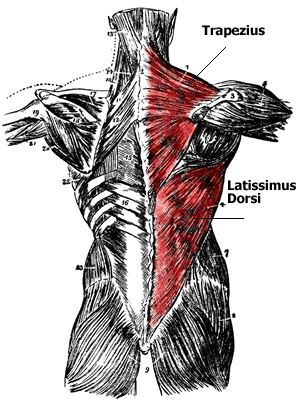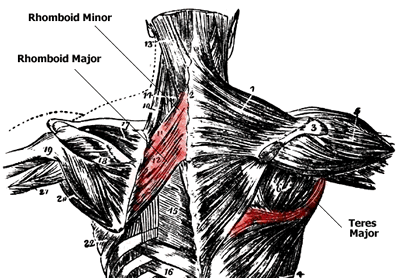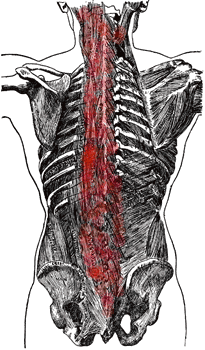The back is a complex anatomical area encompassing a large number of muscles and movements.
We'll start with the two largest muscles of the back musculature... the lats and traps.

Anatomy Chart courtesy of FCIT
The Latissimus Dorsi muscles (also known as the Lats) are the largest muscles of the back. Being large, fan-shaped muscles, they are able to provide force in a wide range of body positions, e.g. leaning back to straight vertical and all points in between.
The Lats are attached to the upper end of the humerus with fibers running down in a fan down the vertebral column and pelvic girdle.
The Trapezius (trap) muscle is a long, trapezoid-shaped muscle that runs down the upper section of the spinal cord, originating at the base of the skull, down the spine and in the middle back, attaching to the scapulae.
The angles of the Trapezius fibers provide pull in three different directions: up, down and in towards the centerline of the body. These actions are performed by the three different sections of the muscle...upper, middle and lower traps.
Functions of the Latissimus Dorsi and Trapezius Muscles
The function of the Latissimus Dorsi is to pull the arm down towards the pelvis. When the arm is fixed (e.g. during a chin-up), the lats serve to bring the body up towards the arm. It is the same basic movement but with the directions reversed. The Lats also function to stabilize the torso during many movements, including the flat bench press.
Upper traps primarily function to elevate the shoulder girdle (scapular elevation). The middle traps draw the shoulder blades together towards the mid-line of the body, called retraction. The lower traps pull the shoulder blades downwards (scapular depression). All of the sections of the traps also work to stabilize and anchor the scapulae during upper body movements that involve the limbs.
Lat Exercises
Exercises that work the Latissimus Dorsi include:
|
Trapezius Exercises
Exercises that work the Trapezius include:
|
|
Anatomy of the Upper Back
The upper back is a complex area containing a number of muscles that perform various actions on the scapulae (shoulder blades) and humerus.

Anatomy Chart courtesy of FCIT
The Teres Major muscle originates on the outer (lateral) edge of the scapula and attaches to the humerus.
The Teres Major muscles work with the Rotator Cuff muscles to stabilize the shoulder joint and works with the Latissimus Dorsi muscles to pull the humerus back.
The Rhomboids (Major and Minor) originate on the spinal column and attach to the middle (medial) surface of the scapula.
The Rhomboid muscles get their name from their shape: rhomboid. The Major and Minor designations refer to their relative size to each other.
Functions of the Upper Back Muscles
The function of the Teres Major is to move the humerus posteriorly, meaning that it brings the arm towards the back.
The Rhomboids function to bring the scapula in towards the spinal column, essentially squeezing the shoulder blades together when the Rhomboids of both sides are used at the same time.
Exercises for the Upper Back Muscles
Exercises that work the Teres Major and Rhomboids include:
|
|
Spinal Erector Muscles
The Erector Spinae is a group of muscles that support the spinal column. They include the Longissimus, the Spinalis and Iliocostalis. The muscles of the Erector Spinae attach to the vertebrae, the ribs and the pelvis.

Anatomy Chart courtesy of FCIT
The functions of the Erector Spinae group are to extend the spine as well as provide support for it.
Exercises that work the Erector Spinae include hyperextensions, deadlifts and good mornings.
Visit the Back Exercise Index for more exercises that work your lats, traps, upper back and spinal erectors.
![]()
More From Fitstep.com
Share This Page...
---
Home -> Exercise Library -> Muscle Anatomy Index -> Back Muscle Anatomy



